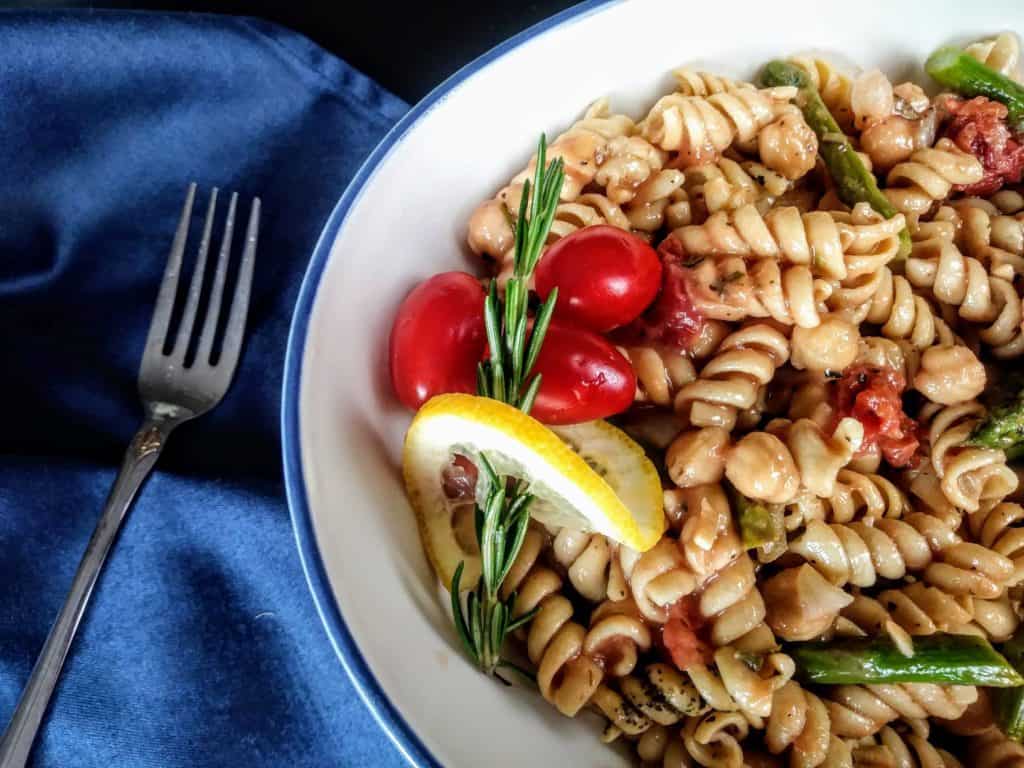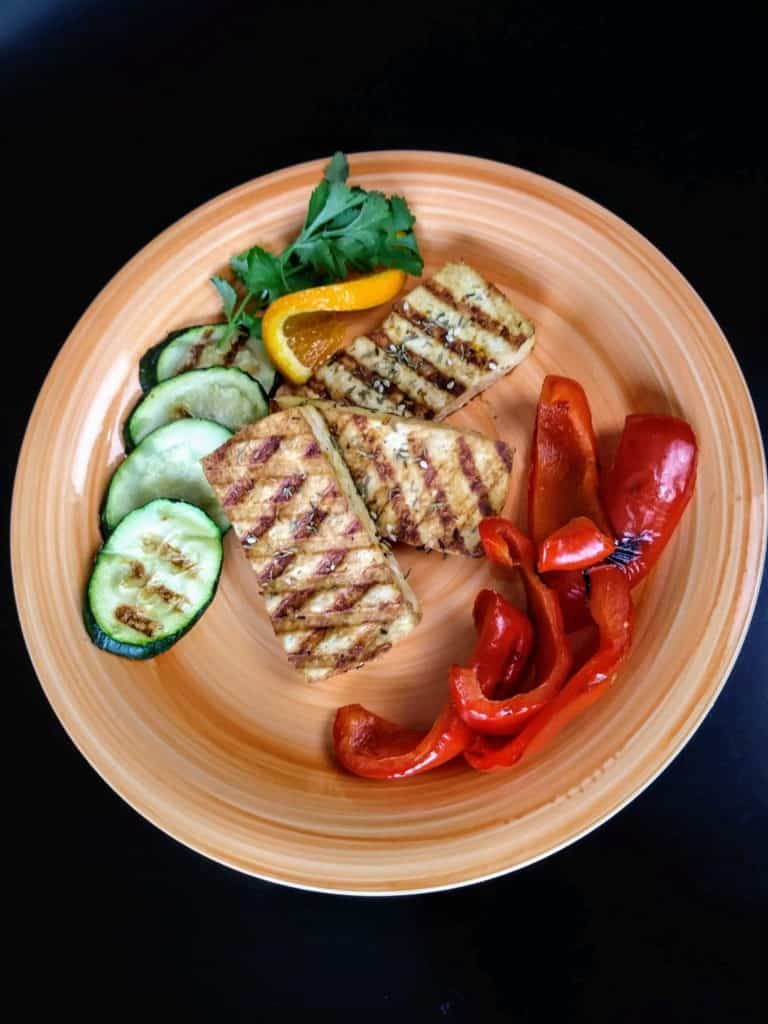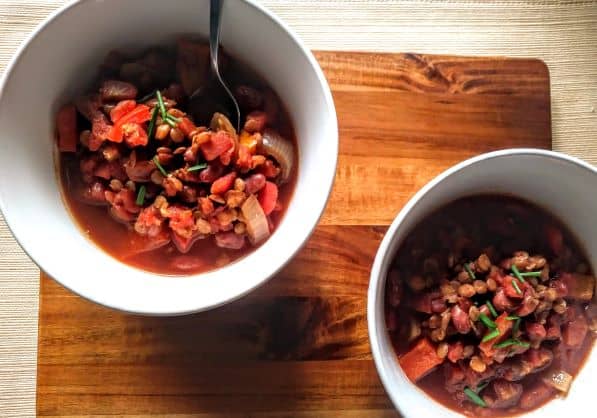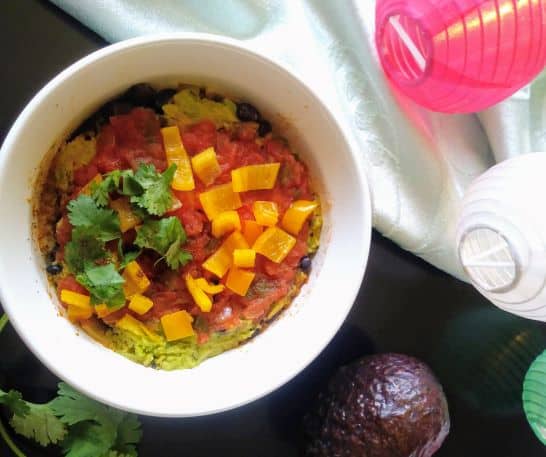Try this quick Thai peanut tempeh with rice for a tasty lunch or dinner with creamy sauce, chewy tempeh, and tender-crisp vegetables. It is a vegan recipe and high in protein and fiber: perfect for a quick weeknight meal!
What is Tempeh?
Tempeh is made from fermented soy or other beans. Some brands may include barley, brown rice, millet, or other grains. Some brands contain gluten. The satisfying chewy texture in tempeh can be appealing to omnivores who are switching to a plant-based diet. You can slice it thinly, season it, and bake it for a savory bacon replacement.
Marinated, grilled slices of tempeh are great in sandwiches or wraps or for salads. You’ll find tempeh in the refrigerated section, but not all grocery stores carry it. While it can be eaten right out of the package, I think it tastes much better cooked. Here are some more cooking ideas for tempeh from America’s Test Kitchen.
For the brand I purchased, a serving is 4 ounces (half of a package). This Thai peanut tempeh with rice recipe serves two for a generous dinner portion.
Unlike tofu, tempeh freezes very well. I have frozen it for a few months with no change in texture or flavor. Like tofu, tempeh doesn’t have much flavor on its own. While some describe it as nutty, I don’t really detect that. You also don’t have to press out the water like you do with tofu, so that saves time.
Nutrition in Tempeh
A 4-ounce portion of tempeh contains about 17-20 grams of protein, which is a lot for a vegan protein source! It has 4-9 grams of fiber – way better than meats or cheeses which all have none. One serving provides 15% of the Daily Value for iron and 10% of the Daily Value for iron.
This is also especially helpful for vegans. It contains no to minimal sodium. One serving has 16 grams of carbohydrates, 120 – 170 calories, and 7-11 grams of fat. Only 2 grams are saturated, and the rest are heart-healthy unsaturated fats (source: package label).
Thai Peanut Tempeh Ingredients

- Avocado oil – this is high in monounsaturated fats and has a high smoke point so it’s a good choice for stir-fries. Peanut, grapeseed, or canola oil are fine substitutes.
- Sesame oil – imparts a wonderful, rich flavor. Just use it in small amounts. it should be stored in the refrigerator for freshness. Take it out a little while before you use it because some of the fat solidifies when cold.
- Peanut butter: I prefer creamy, but you can use crunchy if you prefer.
- Red curry paste: – this is a staple of Thai cuisine and includes red chilis, lemongrass, garlic, kefir lime leaves, and salt. If you avoid seafood, check the label as some brands may contain fish or shrimp paste. It is not very spicy in my opinion but provides some pleasant flavor notes. While you could make red curry paste yourself, I buy it jarred. If you like spicy flavors, add a little of cayenne pepper.
- Reduced sodium soy sauce – use this or tamari sauce to limit the sodium from regular soy sauce. If you don’t have these, you can also just use a little less soy sauce.
- Frozen stir-fry vegetable blend – I like a mix of broccoli, mushrooms, mini ears of corn, water chestnuts, carrots, and snow peas for a super-convenient side dish or ingredient in main courses. Did you know that frozen vegetables often contain more vitamins than fresh ones? But if you don’t have this, you can substitute it with a variety of fresh or frozen vegetables.
- White rice – We often have extra cooked rice: I suggest using organic long-grain rice from California, or organic jasmine or basmati rice: learn more about how to limit arsenic in rice including rinsing, soaking in water, and cooking in extra water and draining it (like you are cooking pasta), with the tips in this article from Dartmouth: Arsenic and You. Try cooked quinoa, amaranth, or wild rice for variety. It would also go well with cooked noodles.
- Green onions – try the green parts of these or a little Thai basil, chopped peanuts, cilantro, lime wedges, or chives for a garnish.
Cooking Tips
After hearing the oil and stir-frying the tempeh for a couple of minutes, add the vegetables, soy sauce, peanut butter, and red curry paste.

This cooks for about 5 minutes, or until hot. If the tempeh and frozen frozen vegetables are not heated through, cover the pan for a few more minutes.
Then, and heat for another 3 minutes on medium heat with the lid on.
Add the fresh black pepper and top with sliced green onions for garnish, serve with the heated rice, and you’re ready to enjoy it!
More Recipes You May Enjoy
- Sesame Ginger Noodles with Tofu and Vegetables
- Vegan Fajita Bowls with Tempeh
- Baby Bok Choy with Tofu Stir-Fry
- Vegan BLT Salad with Avocado Dressing
- 15 Best Vegan Tempeh Recipes
- Slow Cooker Vegan Chili
Updated 6/25/25. Originally published: 3/29/20.

15-Minute Thai Peanut Tempeh with Rice
Ingredients
Equipment
Method
- Heat the avocado or other neutral oil in a wok or large frying pan over medium to high heat for 30 seconds. Add the tempeh squares and cook them for two minutes. Stir them occasionally to prevent them from burning.
- Add the peppers, onions, frozen stir-fry vegetables, and soy sauce to the wok. Continue cooking for another five minutes, stirring a few times.
- Add the peanut butter, water, red curry paste, cooked rice, and freshly ground black pepper to taste. Cover the wok or pan with a lid and turn down the heat to medium. Cook another three minutes or until hot, and then stir in the toasted sesame oil.
- Microwave the leftover cooked rice in a microwave-safe for a minute until hot.
- Turn off the heat and stir in the sesame oil. Portion half of the tempeh-vegetable mix and half of the rice onto each plates and garnish with the green onions.
Nutrition
Notes
Tried this recipe?
Let us know how it was!Keep up to date with seasonal recipes from my free new monthly newsletter.
How did you like this Thai peanut tempeh recipe? Please rate this recipe and leave a comment below:








Lacked flavor and was very dry. Won’t be using this recipe again.
Hello Tess,
Thanks for trying the recipe and taking the time to leave a comment. I’m sorry it didn’t work out well for you.
There is likely variability with the temperature of the heat and perhaps with the rice. I suggest adding a couple of tablespoons of water to the pan while cooking.
Hello Tess,
Thanks for trying the recipe and taking the time to leave a comment. I’m sorry it didn’t work out well for you.
There is likely variability with the temperature of the heat and perhaps with the rice. I suggest adding a couple of tablespoons of water to the pan while cooking.
This recipe is making my mouth water. I will be making it very soon! Thank you!
It was absolutely fantastic! Great flavors and very easy to make.
I’ve never cooked tempeh before and this looks like a great way to use it!
we love tempeh and its easy to prepare and good source of protein too.
This looks incredible. I will try it with some cauliflower rice for a low carb alternative. Yummo!
That is a good idea, Megan. I hope you like it!
How fun! I just tried tempeh for the first time last week and I really needed a new tempeh recipe. This sounds outstanding. I’ve been trying to eat less meat and I’m going to try to use tempeh more often. It’s a great substitute and is economical as well. Thank you for the recipe!
I love Thai food and this recipe is just packed with flavor! My whole family absolutely loved it and I’ll definitely be making it again soon! Thanks for sharing!
Thanks so much for the review, Elizabeth.
I have never cooked with tempeh before, but after reading this post I am going to buy some today and make this dish! It looks so healthy!
I was a bit funny about tempeh but this recipe completely changed my mind, it was so good and full of flavour!
This is such a great way to incorporate tempeh into your diet. I’ve been trying to eat more plant-based protein and I really llike tempeh made this way! Super easy.
So many great flavours all in one recipe! I love it.
I love the sound of the flavours in this. It looks like a great, healthy, midweek meal.
I love anything with those great asian peanutty flavours!
Thank you for taking the time to write a review, Chloe!